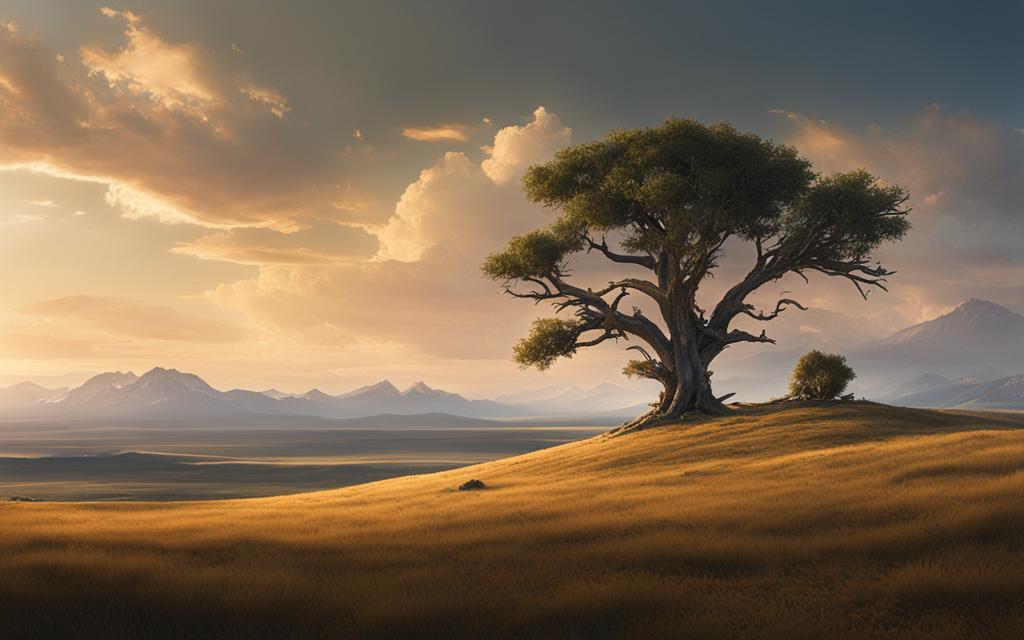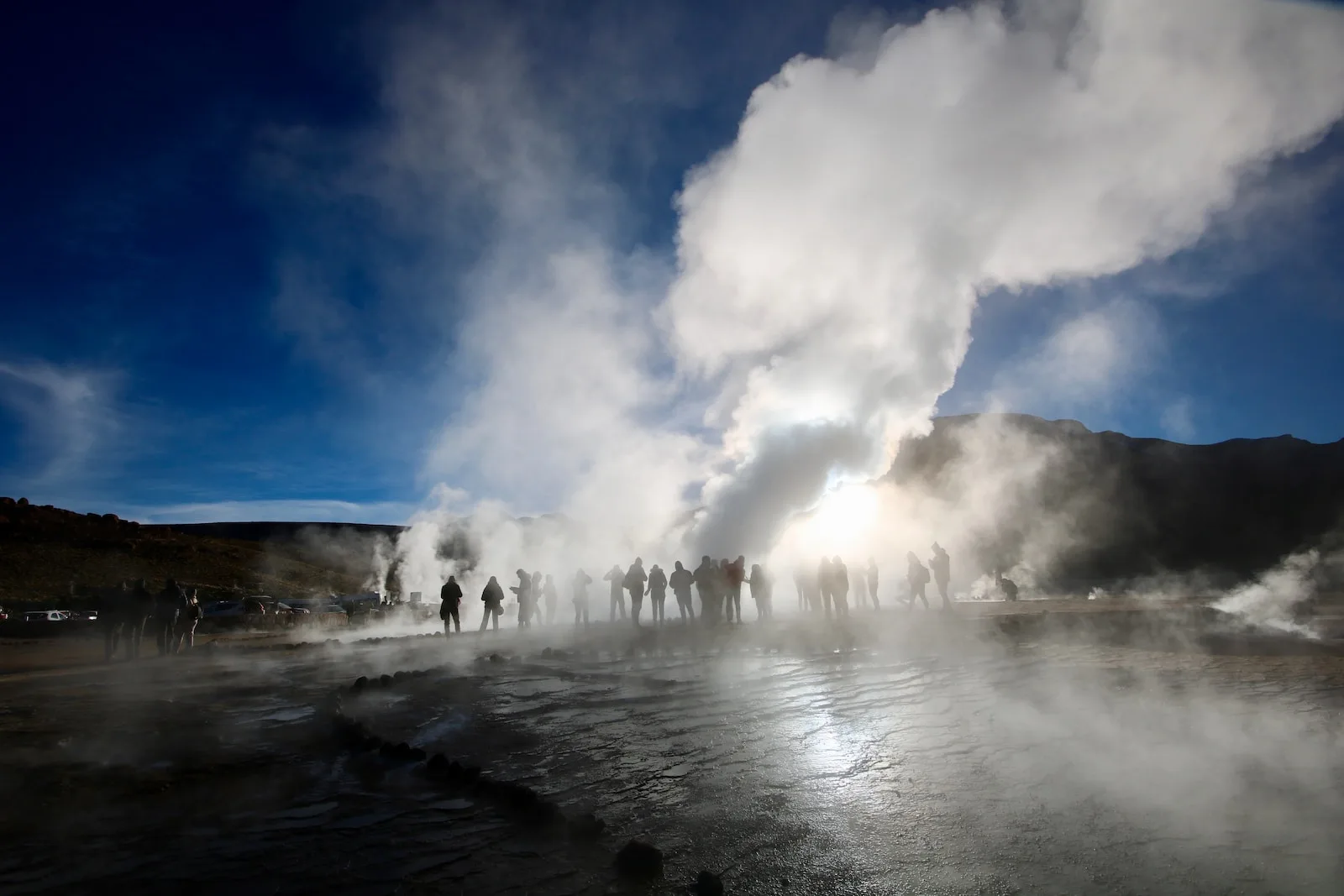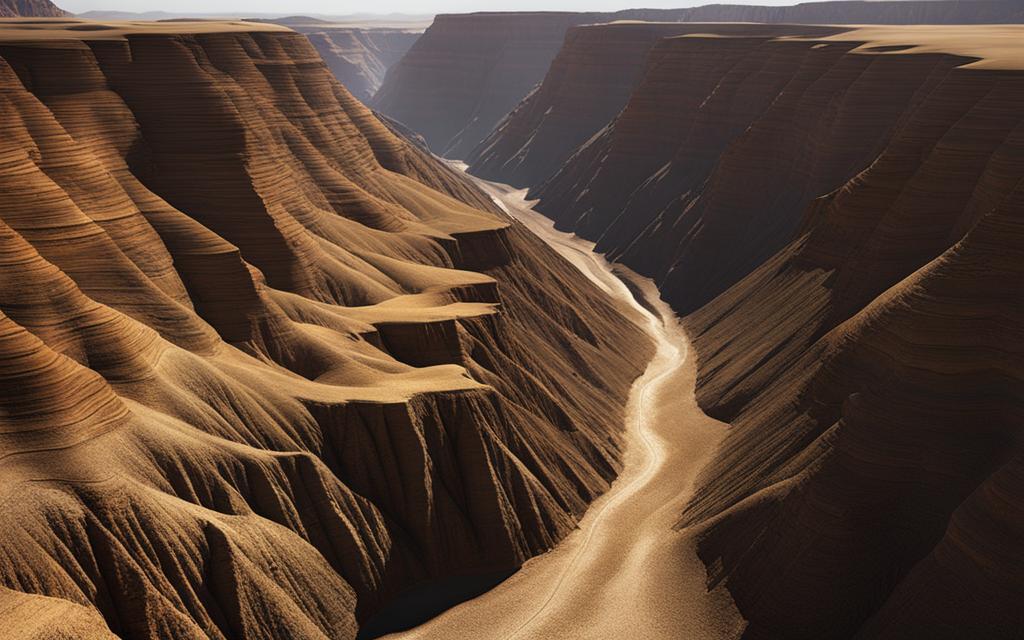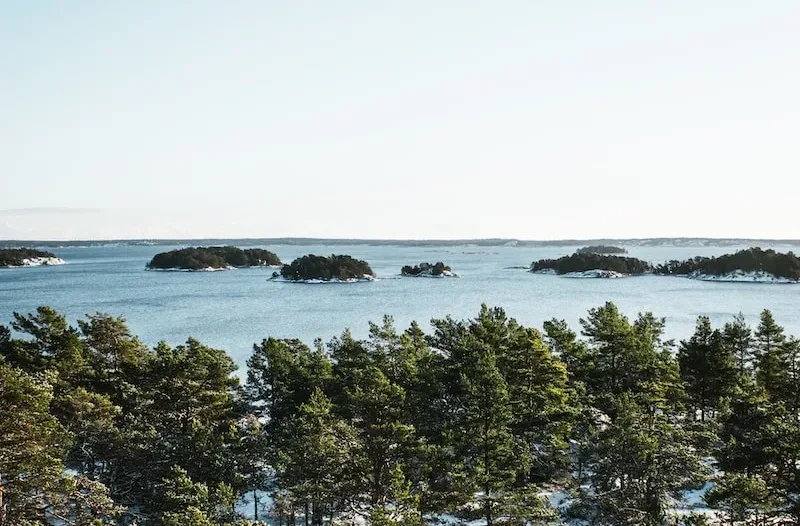Plains and plateaus are both types of flat land, but they differ in terms of elevation. Plains are low-lying areas, while plateaus are raised significantly above the ground. This distinction is important in understanding their unique characteristics and roles in our ecosystem.
Key Takeaways:
- Plains and plateaus are flat landforms with different elevations.
- Plains are low-lying areas, while plateaus are raised above the ground.
- Plains are vital for agriculture, providing fertile soil for crops and grazing.
- Plateaus offer unique geological features and varying living conditions.
- Understanding the differences between plains and plateaus is crucial in appreciating our planet’s diverse landscapes.
Characteristics of Plains
Plains are a type of geographical feature characterized by their flat and low-lying nature. They cover a significant portion of the Earth’s land surface and can be found in various locations, including lowlands, valleys, and even on top of plateaus. Plains are formed through multiple processes, such as erosion, river movements, and volcanic activity.
One of the defining physical features of plains is their flatness, which makes them ideal for agricultural purposes. Fertile plains and grasslands provide suitable conditions for crop production and grazing livestock. Some notable examples of plains include the Great Plains in North America, the Tabasco Plain in Mexico, and the plains of Sichuan in China.
The geography of plains plays a crucial role in shaping their characteristics. The gradual slope of plains helps in the smooth flow of rivers and streams, contributing to the formation of alluvial plains. These plains, created by the deposition of sediment carried by rivers, are known for their fertile soil. Coastal plains, on the other hand, are flat areas adjacent to seacoasts, shaped by a combination of factors like erosion, sediment deposition, and sea-level changes.
Physical Features of Plains:
To better understand the physical features of plains, let’s take a look at the following table:
| Physical Feature | Description |
|---|---|
| Fertility | Plains are often rich in nutrients, making them highly suitable for agricultural activities. |
| Flatness | Plains are characterized by their flat and low-lying terrain, offering expansive views. |
| Water Resources | Plains are often intersected by rivers and streams, providing a reliable water source. |
| Grasslands | Many plains are covered with vast grasslands, supporting diverse ecosystems and grazing animals. |
| Agricultural Productivity | Plains offer favorable conditions for agriculture, contributing to high crop productivity. |
Understanding the characteristics and physical features of plains is essential in appreciating their significance in our ecological system. These flat lands not only provide agricultural opportunities but also serve as vital habitats for numerous species, contributing to the overall biodiversity of our planet.
Classification of Plains
Plains, as flat landforms, can be classified into different types based on their structures and formations. Understanding these classifications helps us appreciate the diverse nature of plains and their ecological significance. The three main types of plains are coastal plains, alluvial plains, and floodplains.
Coastal Plains
Coastal plains are flat areas that lie adjacent to a seacoast. They are formed through a combination of factors such as sediment deposition, erosion, and sea level changes. Coastal plains can extend for miles and are characterized by their proximity to the ocean and the unique ecosystems that thrive in these areas.
Alluvial Plains
Alluvial plains are formed over time by the deposition of sediment carried by rivers. These plains are typically found in river valleys and deltas, offering fertile soils that support agriculture. The sediment deposition process contributes to the continuous growth and expansion of these plains, creating a dynamic landscape.
Floodplains
Floodplains are flat areas alongside streams or rivers that are prone to periodic flooding. These floods occur when the water volume in the river exceeds its channel capacity, causing water to overflow onto adjacent areas. Floodplains play a crucial role in controlling and absorbing floodwaters, as well as providing habitats for diverse plant and animal species.
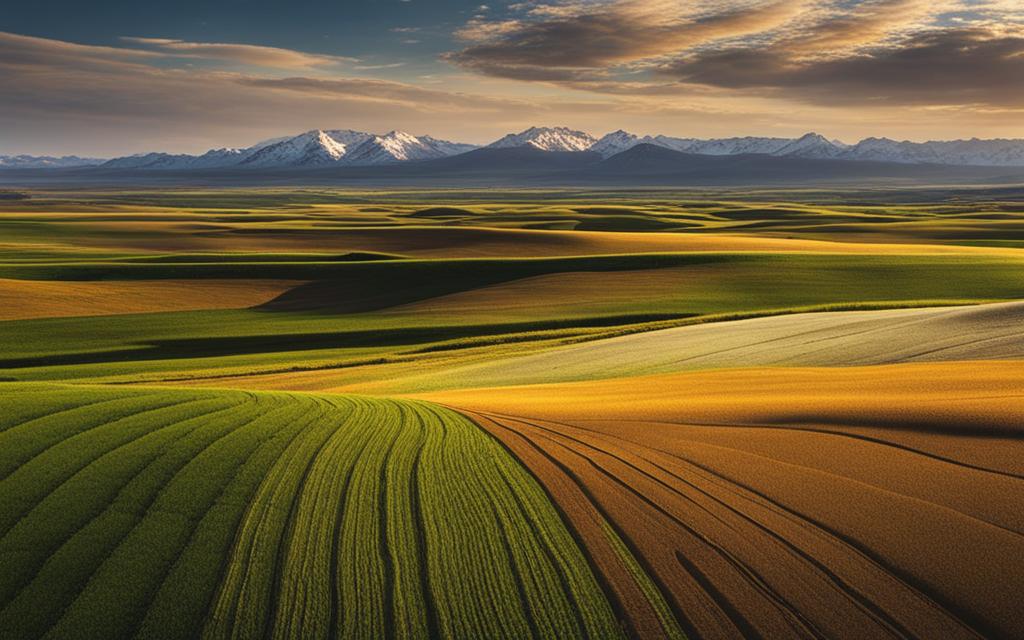
The table below summarizes the key characteristics of each type of plain:
| Type of Plain | Formation | Location | Ecosystem |
|---|---|---|---|
| Coastal Plains | Deposition of sediment, erosion, sea level changes | Near seacoasts | Diverse marine life, coastal vegetation |
| Alluvial Plains | Deposition of sediment carried by rivers | River valleys, deltas | Fertile soil for agriculture, diverse flora and fauna |
| Floodplains | Periodic flooding of rivers | Alongside streams and rivers | Diverse wetland ecosystems, floodwater absorption |
Characteristics of Plateaus
Plateaus are unique landforms that exhibit distinctive characteristics in terms of their geography and physical features. These elevated flatlands differ from plains in many aspects, offering a diverse range of landscapes and climatic conditions.
One prominent characteristic of plateaus is their flat-topped appearance, resembling tabletops or flat-topped mountains. This distinct feature sets them apart from the gradual slopes typically found in plains. Plateaus can be formed through various geological processes, such as volcanic activity or erosion wearing down the tops of mountains.
One notable example of a plateau is the Tibetan Plateau, which is both the highest and largest plateau in the world. It is characterized by its extreme altitude and cold climate, making it a challenging habitat for many species. However, plateaus at lower elevations can provide more favorable living conditions and are often utilized for grazing livestock.

Plateaus Geography
Plateaus can be found in various regions around the world, each with its own unique geography. Some plateaus, such as the Colorado Plateau in the United States, are situated in the interior of continents and are surrounded by mountains on all sides. These are known as intermontane plateaus.
Other plateaus, like the Deccan Plateau in India, are bordered by plains or the sea on one side and mountains on the other. These are called piedmont plateaus. Continental plateaus, on the other hand, are characterized by being surrounded by the sea or plains on all sides.
Additionally, plateaus can also be formed through volcanic activity, resulting in volcanic plateaus. These plateaus are created when lava and volcanic ash accumulate and solidify over time.
Overall, plateaus offer a diverse range of landscapes and geological features, contributing to the rich diversity of our planet’s topography.
Classification of Plateaus
Plateaus come in different types based on their formation and surrounding geographical features. Understanding these classifications is essential in comprehending their distinct characteristics and origins.
| Type of Plateau | Description |
|---|---|
| Intermontane Plateaus | These plateaus are bordered by mountains on all sides, creating a unique and enclosed geographical setting. Intermontane plateaus often result from tectonic forces and can be found in regions such as the Colorado Plateau in the United States. |
| Continental Plateaus | Continental plateaus are characterized by being surrounded by the sea or plains on all sides. They can extend across vast areas and play significant roles in shaping the regional climate. The Deccan Plateau in India is an example of a continental plateau. |
| Volcanic Plateaus | This type of plateau is formed through volcanic activity, where lava flows and volcanic ash build up over time, creating a flat landmass. Examples of volcanic plateaus include the Columbia Plateau in the United States and the Deccan Traps in India. |
Each classification of plateau offers unique features and geological origins. Intermontane plateaus are defined by their mountainous surroundings, continental plateaus by their proximity to the sea or plains, and volcanic plateaus by their volcanic origins. These distinctions contribute to the diverse landscapes found across the globe.
Understanding the various types of plateaus allows us to appreciate the geological processes that shape our planet and the role plateaus play in creating diverse ecosystems. From the towering peaks of intermontane plateaus to the expansive flatlands of continental and volcanic plateaus, these elevated landforms offer a glimpse into the Earth’s dynamic history and the forces that shape its surface over time.
In the next section, we will compare the characteristics of plains and plateaus to further understand the unique features and roles of these landforms.
Comparing Plains and Plateaus
Plains and plateaus are two distinct types of flat land, each with its own unique characteristics and topography. Understanding the similarities and differences between these landforms is essential in appreciating the diverse landscapes of our planet.
Topography: The main difference between plains and plateaus lies in their elevation. Plains are low-lying areas, while plateaus are raised significantly above the ground. Plains have a gradual slope, while plateaus rise abruptly from the surrounding area. This difference in elevation gives each landform its distinct geological features and ecological significance.
Climate and Living Conditions: Plains generally offer favorable living conditions and fertile soil for agriculture. They are often used for crop production and grazing livestock due to their flat terrain and ample water supply. In contrast, plateaus can have harsh climates and less supportive conditions for farming. The high altitude and cold climate of some plateaus, such as the Tibetan Plateau, make them challenging places to inhabit. However, plateaus at lower elevations can provide more favorable living conditions and are often used for grazing animals.
Plains and plateaus are both essential components of the Earth’s landscape. While plains are characterized by their low elevation and fertile soil, plateaus are known for their raised topography and unique geological formations. Understanding the differences between these landforms allows us to appreciate the beauty and diversity of our planet’s terrain.
Comparative Table: Plains vs Plateaus
| Plains | Plateaus |
|---|---|
| Low-lying areas | Raised significantly above the ground |
| Gradual slope | Abrupt rise from the surrounding area |
| Favorable living conditions and fertile soil | Varied living conditions, can be harsh at higher elevations |
| Used for agriculture and grazing | Used for grazing animals, farming less common in harsher climates |
Table: A comparison of the key features of plains and plateaus.
Conclusion
In conclusion, plains and plateaus are two distinct types of flat land that play important roles in our ecosystem. The main difference between them lies in their elevation. Plains are low-lying areas, while plateaus are significantly raised above the ground.
Plains are known for their gradual slopes and fertile soil, making them ideal for agriculture. They provide crucial land for crop production and grazing livestock. On the other hand, plateaus have unique geological features, with flat tops resembling tabletops or flat-topped mountains. While some plateaus offer harsh living conditions due to high altitude and cold climate, others at lower elevations can provide more favorable conditions for grazing animals.
Understanding the characteristics and distinctions between plains and plateaus is essential in studying the diverse landscapes of our planet. Whether it’s the vast grasslands of the Great Plains or the towering peaks of the Tibetan Plateau, these landforms have shaped our environment and continue to play significant roles in our ecosystems.
FAQ
What is the difference between plains and plateaus?
Plains are low-lying areas, while plateaus are raised significantly above the ground.
What are the characteristics of plains?
Plains are flat, low-lying areas that cover a significant portion of the Earth’s land surface.
How are plains classified?
Plains can be classified into different types based on their structures and formations, such as coastal plains, alluvial plains, and floodplains.
What are the characteristics of plateaus?
Plateaus are flat lands that are significantly raised above the surrounding ground.
How are plateaus classified?
Plateaus can be classified into various types based on their formation and surroundings, such as intermontane plateaus, continental plateaus, and volcanic plateaus.
How do plains and plateaus compare?
Plains generally offer favorable living conditions and fertile soil for agriculture, while plateaus can have harsh climates and less supportive conditions for farming.
 Skip to main content
Skip to main content